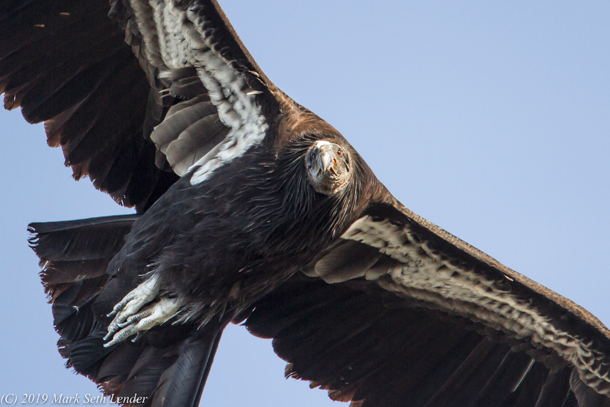Field Note: Get the Lead Out!
Published: June 3, 2019
By Mark Seth Lender

A condor comes by for a closer look. (Photo: Mark Seth Lender)
Living on Earth’s Explorer in Residence Mark Seth Lender muses on an encounter with one of Earth’s most impressive birds: the California Condor.
The bald head of a California condor (for the sake of cleanliness they have no head feathers) is hot to the touch. Their body temperature runs 104 to 105 degrees Fahrenheit. Despite the high temperature the birds have a relatively low basal metabolic rate. They can survive long periods of starvation, and they are very long-lived. At least 45 years in the wild, maybe longer. This, if they do not succumb to lead poisoning.
Virtually all lead bullets are now alloyed with antimony, causing fragmentation on impact – this a WWII combat innovation. Generally speaking, under battle conditions, no one ate their targets. But both human hunters and condors are now eating fragmented lead left respectively, in the flesh of a kill hunters pack up and take home, and in the entrails and organs hunters leave behind. Animals shot and wounded who get away and go off to die (which happens more often than people care to admit) also become carrion readily accessible to condors, and other animals too. There is evidence that lead fragments cause brain damage in humans, especially to children. Lead kills condors outright. It was a major cause of their decline and, along with habitat loss, the greatest difficulty they now face in the wild. Condor rehabilitation centers, such as the one run by the US Fish and Wildlife Service at Hopper Mountain, are constantly chelating condors for lead poisoning.
Copper ammunition (which though slightly different from lead has excellent ballistics) would eventually eliminate the problem for condors and humans alike, but the NRA is against it.
The first time I saw condors there were seven in formation, the sound of air passing over their wings reminiscent of air whooshing over the wings of a glider. Not something you readily forget. But in addition, and as they have done every time I’ve seen them since, they drifted over to look at me, their wings still, their dark-bright eyes meeting mine. It will be terrible if they are lost to the fabric of Life on Earth.
Listen to Mark Seth Lender read his Mighty Condor essay
Back to Mark Seth Lender Field Notes
Living on Earth wants to hear from you!
Living on Earth
62 Calef Highway, Suite 212
Lee, NH 03861
Telephone: 617-287-4121
E-mail: comments@loe.org
Newsletter [Click here]
Donate to Living on Earth!
Living on Earth is an independent media program and relies entirely on contributions from listeners and institutions supporting public service. Please donate now to preserve an independent environmental voice.
NewsletterLiving on Earth offers a weekly delivery of the show's rundown to your mailbox. Sign up for our newsletter today!
 Sailors For The Sea: Be the change you want to sea.
Sailors For The Sea: Be the change you want to sea.
 The Grantham Foundation for the Protection of the Environment: Committed to protecting and improving the health of the global environment.
The Grantham Foundation for the Protection of the Environment: Committed to protecting and improving the health of the global environment.
 Contribute to Living on Earth and receive, as our gift to you, an archival print of one of Mark Seth Lender's extraordinary wildlife photographs. Follow the link to see Mark's current collection of photographs.
Contribute to Living on Earth and receive, as our gift to you, an archival print of one of Mark Seth Lender's extraordinary wildlife photographs. Follow the link to see Mark's current collection of photographs.
 Buy a signed copy of Mark Seth Lender's book Smeagull the Seagull & support Living on Earth
Buy a signed copy of Mark Seth Lender's book Smeagull the Seagull & support Living on Earth

